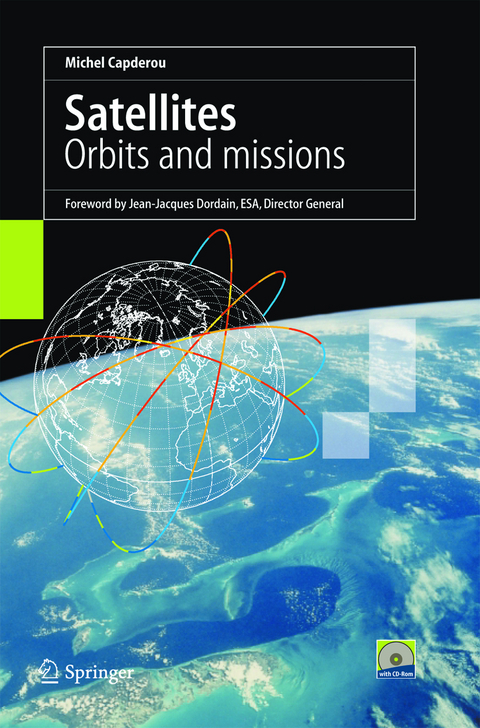
Satellites
Orbits and Missions
Seiten
2005
Springer Editions (Verlag)
978-2-287-21317-5 (ISBN)
Springer Editions (Verlag)
978-2-287-21317-5 (ISBN)
In all, the European Space Agency (ESA) has developed 60 spacecrafts over the last few decades. The main credit of Michel Capderou’s book is to take the reader (whether it be a student, an engineer or a research scientist) progressively from the basic Kepler laws to the most complex equations of space mechanics.
In all, the European Space Agency (ESA) has developed 60 spacecrafts over the last few decades. Some of these, such as the ERS satellites and Envisat, are dedicated to monitoring the Earthand providing vital data on the health status of our planet. Other spacecraft have helped to improve the accuracy of weather forecasting. Galileo, the joint ESA/EU satellite navigation p- gramme, demonstrates the political dimension of space as service-provider for the bene?t of European citizens. While these missions involve utilitarian space activities, others are devoted to either exploring the solar system, - cluding the Sun, or achieving a better understanding of the Universe and the cosmic beginnings. Theorbitsofthesesatellitescoverawiderange(Sun-synchronous,geos- tionary, highly eccentric, at Lagrange points, etc.) so that a complete novice may be astonished when tackling the space technology ?eld. The main credit of Michel Capderou’s book is to take the reader (whether it be a student, an engineer or a research scientist) progressively from the basic Kepler laws to the most complex equations of space mechanics. His educational concern has led him to propose many examples and graphicalillustrations from ESA, but alsofromthe American,Russian,Indian,Japaneseor evenChinese space agencies. These programmes provide scienti?c insights and moreover appear to fascinate the general public, in particular the younger generation. Those wishing to understand the orbital mechanisms behind these programmes will ?nd the explanations they seek in this book.
In all, the European Space Agency (ESA) has developed 60 spacecrafts over the last few decades. Some of these, such as the ERS satellites and Envisat, are dedicated to monitoring the Earthand providing vital data on the health status of our planet. Other spacecraft have helped to improve the accuracy of weather forecasting. Galileo, the joint ESA/EU satellite navigation p- gramme, demonstrates the political dimension of space as service-provider for the bene?t of European citizens. While these missions involve utilitarian space activities, others are devoted to either exploring the solar system, - cluding the Sun, or achieving a better understanding of the Universe and the cosmic beginnings. Theorbitsofthesesatellitescoverawiderange(Sun-synchronous,geos- tionary, highly eccentric, at Lagrange points, etc.) so that a complete novice may be astonished when tackling the space technology ?eld. The main credit of Michel Capderou’s book is to take the reader (whether it be a student, an engineer or a research scientist) progressively from the basic Kepler laws to the most complex equations of space mechanics. His educational concern has led him to propose many examples and graphicalillustrations from ESA, but alsofromthe American,Russian,Indian,Japaneseor evenChinese space agencies. These programmes provide scienti?c insights and moreover appear to fascinate the general public, in particular the younger generation. Those wishing to understand the orbital mechanisms behind these programmes will ?nd the explanations they seek in this book.
Keplerian Motion.- Satellite in Keplerian Orbit.- Satellite in Perturbed Orbit.- Motion of Orbit, Earth and Sun.- Orbit and Ground Track of a Satellite.- Orbit Relative to the Sun. Crossing Times.- Orbit Relative to the Earth. Recurrence and Altitude.- View from the Satellite.- Temporal and Angular Sampling.- Satellites of Mars.- Satellites of Other Celestial Bodies.
| Erscheint lt. Verlag | 17.3.2005 |
|---|---|
| Übersetzer | S. Lyle |
| Zusatzinfo | XX, 544 p. |
| Verlagsort | Paris |
| Sprache | englisch |
| Maße | 155 x 235 mm |
| Themenwelt | Naturwissenschaften ► Geowissenschaften ► Geologie |
| Naturwissenschaften ► Geowissenschaften ► Meteorologie / Klimatologie | |
| Naturwissenschaften ► Physik / Astronomie ► Astronomie / Astrophysik | |
| Technik ► Luft- / Raumfahrttechnik | |
| Technik ► Nachrichtentechnik | |
| Schlagworte | Astronomy • climatology • Geodesy • Geophysics • meteorology • plantelogy • Satellite |
| ISBN-10 | 2-287-21317-1 / 2287213171 |
| ISBN-13 | 978-2-287-21317-5 / 9782287213175 |
| Zustand | Neuware |
| Haben Sie eine Frage zum Produkt? |
Mehr entdecken
aus dem Bereich
aus dem Bereich


